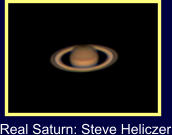Artificial Saturn Details:
Attached is a basic diagram of the fake Saturn construction.
It is simply a back-illuminated transparent image. The image itself was printed onto a transparency slide (via
https://www.digitalslides.co.uk/). A ground glass disc is placed behind it to diffuse the light from a white LED, and a plain glass disc placed
in front to protect the outward-facing side. The LED is powered by a garden solar light circuit allowing it to be a self-contained battery-
powered unit that comes on at night. The whole thing is then placed into a PVC tube for protection.
In our case the image is placed ~100m from the Patrick Moore Building where the Dobsonians are usually set up outside, and the image
was printed at a size so that from 100m it appears to be the true angular size of Saturn at its closest to Earth. This distance also allows
the Dobsonians to reach focus without needing extension tubes. (It will appear about 1/3 larger from where you were set up).
If one didn’t have such a constant distance available, then it would be possible to collimate the image to infinity by placing a lens in front.
The advantage being that it could be placed at any distance from the telescope and it would remain in focus and not change scale. The
disadvantage would be that the alignment of the collimated image and telescope becomes much more critical such that it would not be
possible for multiple telescopes to view the image at once.
I hope this helps,
David
(David Campbell)


Artificial Saturn
Details:
Attached is a basic diagram of the fake Saturn construction.
It is simply a back-illuminated transparent image. The image
itself was printed onto a transparency slide (via
https://www.digitalslides.co.uk/). A ground glass disc is placed
behind it to diffuse the light from a white LED, and a plain glass
disc placed in front to protect the outward-facing side. The LED
is powered by a garden solar light circuit allowing it to be a self-
contained battery-powered unit that comes on at night. The
whole thing is then placed into a PVC tube for protection.
In our case the image is placed ~100m from the Patrick Moore
Building where the Dobsonians are usually set up outside, and
the image was printed at a size so that from 100m it appears to
be the true angular size of Saturn at its closest to Earth. This
distance also allows the Dobsonians to reach focus without
needing extension tubes. (It will appear about 1/3 larger from
where you were set up).
If one didn’t have such a constant distance available, then it
would be possible to collimate the image to infinity by placing a
lens in front. The advantage being that it could be placed at any
distance from the telescope and it would remain in focus and not
change scale. The disadvantage would be that the alignment of
the collimated image and telescope becomes much more critical
such that it would not be possible for multiple telescopes to view
the image at once.
I hope this helps,
David
(David Campbell)



























